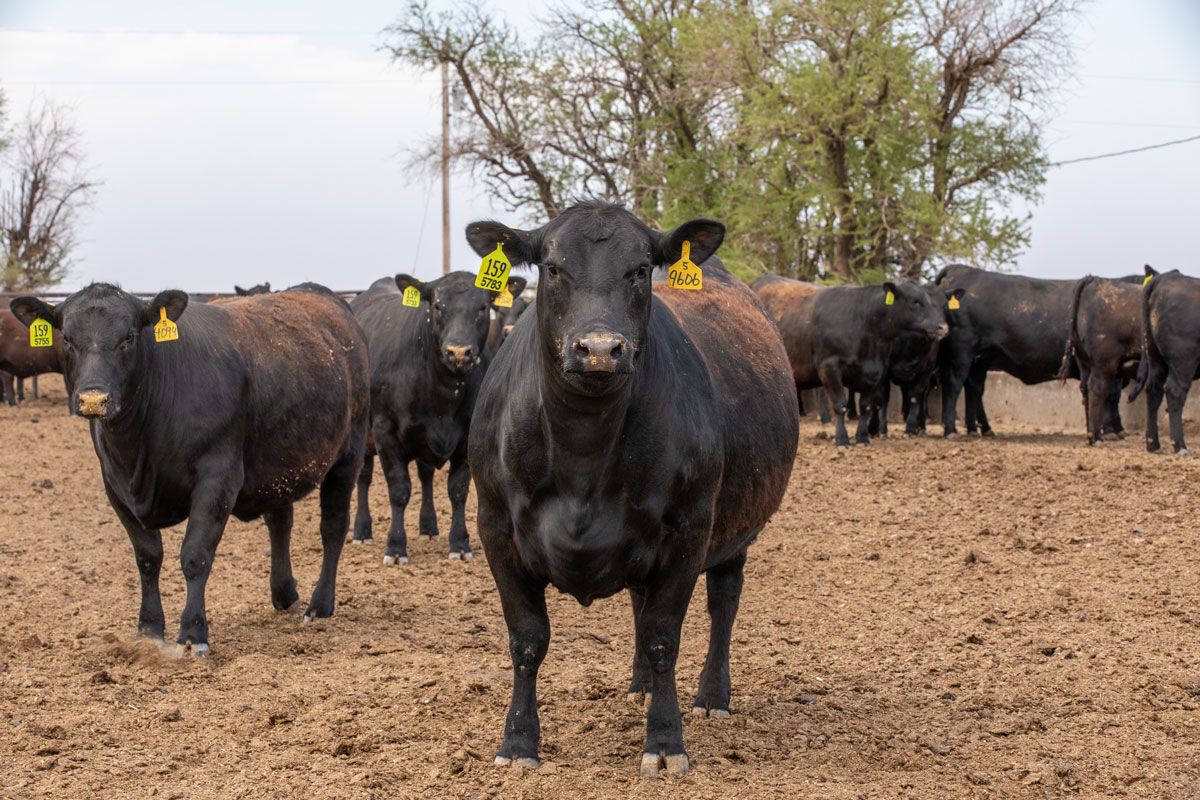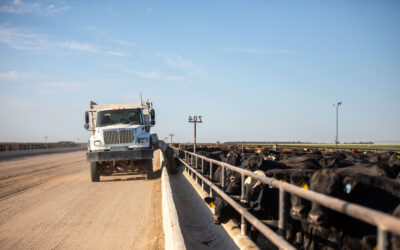
As Predicted
2022 saw increased prices, improved slaughter pace and higher quality grade premiums.
by Paul Dykstra
January 2023
Heading into 2022, we had a relatively solid idea of where the market was headed. The picture just got clearer as the year played out.
Several of the predictions that kicked off 2022 proved true in aspects of the business that are slow to change or predicated by conditions already set in place. Higher input costs in several categories extended their trend through 2022, but were exacerbated by inflation rates higher than anticipated upon initial upticks in 2021. Weather patterns suggested La Nina’s hot and dry conditions would remain throughout the year, culminating in a broader scope of the U.S. in drought conditions through early winter. This furthered the beef cow culling trend while cutting a deeper trough through the cow herd than anticipated in January.
Closer to Normal
The improvement in supply chain throughput at the packing level was a welcome trend shift for all beef business participants. While the first few months of the year, in particular, remained plagued by packing plant workforce shortages as a hangover from COVID, this began to right itself beginning in the second quarter. By mid-year fed cattle slaughter totals were topping prior-year head counts, bringing about a much more current fed cattle supply. Through year’s end the 2022 daily and weekly head counts were often larger than in 2021.
Larger than normal feedlot placements in the spring, spurred by drought conditions in grazing areas, set the stage for larger subsequent finished cattle supplies in Q3 and Q4. Finished cattle became more readily available in the south through this period but the northern tier of the cattle feeding region saw tighter supplies of market-ready cattle. This drove the north-to-south fed cattle price spread to its record-wide range near $10/cwt. in late summer, early fall. Concrete numbers are difficult to source but the southern region’s expanded focus on beef x dairy fed cattle harvested in those fed cattle packing plants played a role in the expanded southern supply.

Price Sensitive to Small Changes in Supply
Further down the supply chain, changes in the fed cattle boxed beef mix impacted price spreads between quality grades and branded beef. The most notable shift was the supply of USDA Prime graded product. Fed cattle carcasses qualifying for the highest USDA quality grade were harder to come by as Prime slipped from 10% of federally graded steers and heifers to 8.9% in 2022. The 1.1 percentage point drop seems hardly worth mentioning, but stated in estimated pounds of carcass weight this translates to an 11% drop below the industry’s 2021 Prime production volume.
The shift to smaller Prime cut availability came just as end users, particularly grocers, had become accustomed to broader availability of the product. As far back as 1997, the year our USDA dataset begins, the industry produced 2 to 3% Prime carcasses every year without fail. But improved genetics, technology and heavier carcasses saw the number move first to 4% in 2014, 5% in 2015 and so on until 2020 and 2021 both notched 10% Prime industry averages. Bolstered, no doubt, by the backlog of fed cattle and heavier carcass weights, those two years were the peak. In 2022 we saw the annual average Prime percentage fall to 8.9%. Yet, retailers had begun including Prime in their meat case as customers proved their commitment to high-quality beef and willingness to pay, coupled with broader availability. Many Certified Angus Beef ® (CAB®) licensed partners began offering the CAB Prime extension in their meat cases, with some smaller chains trading their entire offering up during the past few years. This year’s 11% dip (down 6.8% for CAB Prime) in previously record-large Prime product supplies collided with better-than-ever consumer demand for Prime product. This generated a record-large Prime carcass cutout premium over Choice of $92/cwt. last October, $8/cwt. higher than the previous October high. Cattle feeders pulled in $30 to $33/cwt. Prime grid premiums during this period with Choice already commanding roughly $8.50/cwt. net over the cash carcass price, on average.
The price for quality relationship continued to expand beyond the Prime category, driving a larger spread between Premium Choice, Low Choice and Select. The potentially outdated bellwether “Choice/Select Spread” ranged widely on predictable seasonal fluctuations in carcass grading trends and consumer demand. The low end of the Choice premium range was recognized briefly last February at $3.97/cwt. when weekly Choice production peaked and quality middle meat demand was seasonally low. The top end of the range was 10 times as high as the low with a daily high in late October of $35.69/cwt. premium over Select. Choice premiums climbed from the first half of the year to mark an extended trend of highs during the second half, averaging just over $18/cwt. for the year according to USDA.

A Strong Year for the Brand
Of course, many readers here would look to CAB sales as a more accurate measure of high-quality beef demand. This the brand posted the second largest ever sales volume at 1.234 billion pounds, a 1.6% increase on the prior year. The number of Angus-type animals identified at CAB-licensed packers rose 1.7%, to 16.38 million head eligible for the brand. That’s 70% of the fed steers and heifers nationwide. There was a slight reduction in the percentage that qualified for the brand at 35.5%, but placed in historical context, that was more than double that of 15 years ago. The 1.3 ppt decline in accepted carcasses resulted in a net decline of 2.2% of total certified head count, which was to be expected after inflated marbling levels due to harvest delays and long-fed cattle in the past two years.
Carcass weights through April ran record-large for the period, while the slaughter pace ran slightly below the prior year. The weight trend pulled rapidly lower in May, however, in a trend line essentially matching that of 2021 for the rest of the year. The weighted average fed cattle carcass weight in mid-December was 880 lb., two pounds heavier than the prior year and equal to the record-high 2020 average, brought on by the pandemic backlog. Steers were down 1.8% in the fed cattle mix and heifers increased by 4.8%, pulling the weighted average lower since they were 75 lb. less than their steer counterparts last year.
Increasing carcass weights are not new theme and the betting odds are in favor of continuation of the trend. This is not only true due to the long-term trend for a 5 lb. annual increase in weights, but also due to the exceptional decline in beef cow numbers expected to culminate in 1 million fewer cows in the final January 1 USDA report. Cattle feeders expect to see higher average fed cattle prices in 2023 but also face higher replacement cattle costs. The latter will continue to push breakevens higher and, if history is any predictor, many replacement cattle will be priced above those breakevens. All of those factors place votes in the column for increasing weights going forward as feedyards opt to add days to cattle already on inventory. On the other hand, rising feed input costs pressure feed efficiency on a live weight basis toward the end of the feeding period. This factor keeps cattle feeders that market on a live weight basis cognizant of rapidly disappearing profitability on cattle in the heaviest of weight classes. The beef sector attempted to shore up the fed cattle shortage in 2014-2016 with added weight per head and it will certainly be a factor to watch in the next few years. However, 2022 average carcass weights are already 22 lb. heavier than in 2015-2016.

Lessons Learned
Most know supply and demand factors aligned much more favorably than in any of the previous years as it relates to cattle prices and leverage. Yet, even with exceptional demand the production sector can’t shrug off the cost side of the equation. Fed cattle need to be worth the projected 2023 prices at and above $160/cwt. to generate enough revenue from the feedyard back to the ranch to combat higher input costs throughout the calf’s lifecycle.
If there was a lesson in 2022, it was that the beef market is very sensitive to declines in quality grade, as evidenced through price signals. It’s the first time in recent history where we’ve gone backwards — albeit ever so slightly — and customers are telling us they have unfulfilled demand. That’s reflected in the premiums paid, and that’s saying something after two years of extremely high premiums. We’ve hit a new plateau and the cattlemen who continue to include carcass quality as a piece of their selection criteria will be primed to take advantage.
This story was originally published in the Angus Beef Bulletin.
You may also like
CAB Sets Sales Records, Sees Historically High Brand Acceptance Rates
In an otherwise tough time in the beef business, sales and supply records have been a bright spot. The positive numbers mean that quality beef production has not let up, and beef demand is holding. Consumers have proven the value proposition: the good stuff is worth a little more money, for a better eating experience.
Feeding Quality Forum Dates Set Earlier in August
When you’re feeding cattle, it counts to keep track of every calf, pound and dollar. Beyond the event’s educational sessions, networking between segments of the beef supply chain is invaluable—from feeders and cow-calf operators to allied industry and university researchers.
Gardiners Highlight Service, Strength at Foodservice Leaders Summit
Mark Gardiner and his son, Cole, of Gardiner Angus Ranch offered a boots-on-the-ground perspective for CAB specialists attending the annual event, designed to deliver resources that help train foodservice teams and serve consumers at a higher level.



